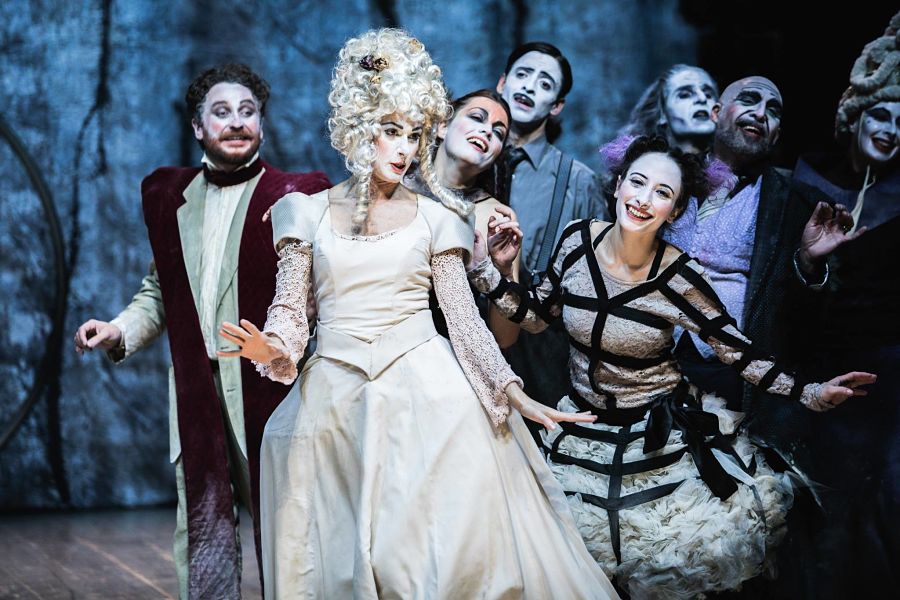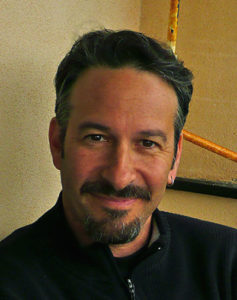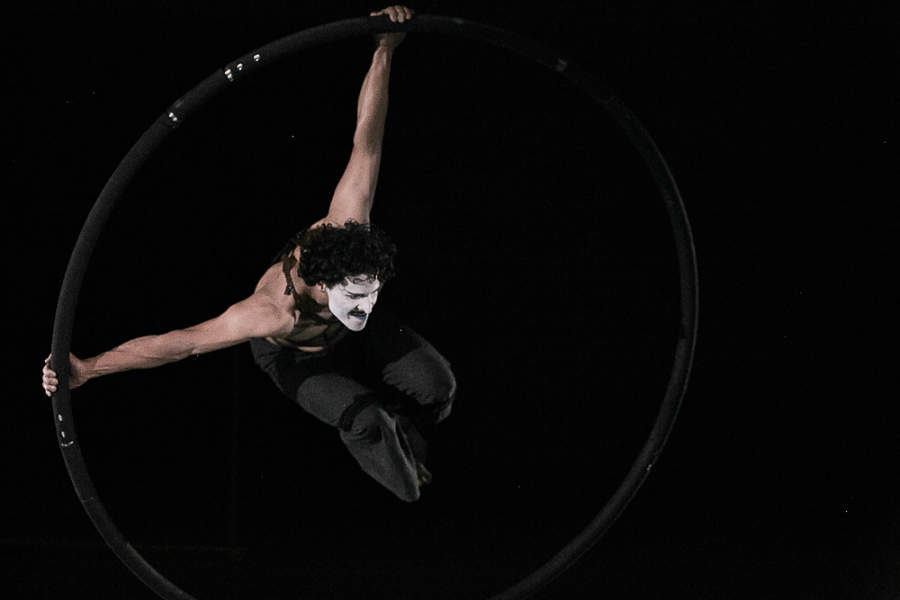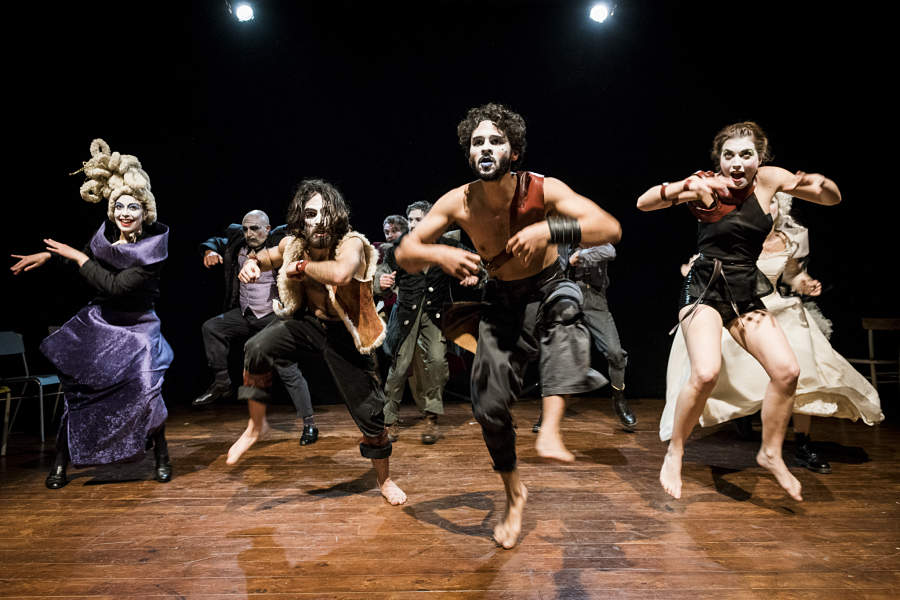“It is not the object of art to make life comfortable for the fat bourgeois so that he may nod his head: ‘Yes, yes, that’s the way it is! And now let’s go for a bite!’ Art, insofar as it seeks to educate, to improve men, or to be in any way effective, must slay workaday man; it must frighten him as the Mask frightens a child, as Euripides frightened the Athenians who staggered from the theatre. Art exists to change man back into the child he was…we want theatre. We seek the most fantastic truth. We search for the superdrama.”
—Yvan Göll,1922
Last spring I found myself in Castelfiorentino, Tuscany, a sleepy hamlet nestled into the voluptuous green hills of central Italy. It was April 7 and I was sitting in the foyer of the Teatro C’art, where a milling crowd was waiting to see SALT (The Marvellous Puppet Show) by the visiting multinational theatre company Bämsemble, which are based in Milan and Turin. Teatro C’art’s resident company is primarily a clowning ensemble, and the walls are scattered with framed photos of past productions, all featuring images of the classical European clown, some with white face, all with red noses, pictured among surrealist props radiating whimsy.
An open mezzanine area upstairs was littered with these props: a sousaphone stuffed with flowers, an antique black bicycle with huge, white feather wings. As I beheld this sweet and idiosyncratic space, a friend told me that the rows of steel strings under the handrail for the stairs had all been tuned to different pitches, so the building itself could be played.
Behind the door leading into the theatre, we could hear the sound of musicians warming up—a shaker, mandolin scales, a drumroll—as various members of the company rushed in and out, bursting through the pre-show fourth wall with abandon, their urgency reminding me that this was a work-in-progress performance. Then from behind the door came the sound of a rumbling roar of voices, the company warming up in unison.
SALT (The Marvellous Puppet Show) is the first major production from Bämsemble, which formed in 2017. The show is directed by Jon Kellam, who founded the company with Andrea Bochicchio and Andrea Cavarra, the show’s producer. Kellam’s co-director, co-movement director and co-choreographer for SALT is Madeleine Dahm, a theatre director and dance practitioner who instructs the company in elements of Graham technique, Laban, and BodyWeather.
The show’s dossier describes Bämsemble’s mission to present “an innovative, unique, and contemporary approach to commedia dell’arte” and tells the story of how SALT began as a theatre “laboratory” for Kellam to experiment with a new method he calls “Superdrama.” I learn later from Kellam that Superdrama is based on the Style acting method, which he learned during tenures with New Crime Productions in Chicago and as an actor and director with Tim Robbins’ Actors’ Gang in Los Angeles. Kellam tells me that the Style synthesized “commedia dell’arte, German Expressionistic images, and melodramatic emotion” to create “a kind of heightened, punk-rock-like dynamic theatre that I found irresistible.”
Kellam left L.A. for Europe in 2013 to work with European performance ensembles, study clowning, and garner an MFA in physical theatre at the Accademia dell’Arte in Arezzo, Italy. Kellam explains that his version of the Style has become so infused with other elements acquired in the course of his career that it has now lifted off into its own unique methodological niche, requiring a new name; hence Superdrama.
I am curious to see the show and experience the results emerging from Kellam and his collaborators’ theatre laboratory. Have they have made gold out of their new methodological alchemy? I am also curious to find out more about the origins of Superdrama, how it arose from Kellam’s particular history as an American theatre artist travelling to Europe in search of new and ancient perspectives.
It is now time for the show, and we all file into a little black-box studio theatre. The stage is mostly bare: The left edge is lined with musical instruments attended by two musicians, the right edge holds a row of chairs. The only other object is a large black hoop, the diameter of a tall man, resting against the back wall, opposite the audience. The lights go down, and the actors file in and sit on the chairs.
Into the darkness a disembodied man’s voice, amplified and distorted, begins speaking, “My name is Don Miguel, and when I was born, I started laughing. My shouts of joy have crossed the mountains and stretched over the sea. I am the king of time, generated at the beginning. I am the cry of life that wants to live.”
The script is written by Italian playwright Francesco Botti and story adapted by Botti and Kellam from the theatrical interlude El Retablo de Las Maravillis (The Marvellous Puppet Show), written in 1615 by no less than Miguel de Cervantes. The adaptation is set in a dystopian near-future, and begins when three foreign actors and con artists—the leader Chanfalla, his lover and companion Chirinos, and Rabelin, a young man learning their trade—crash their motorcycle and sidecar near a town encircled by a tall, white wall of salt. They are met outside of the walls by the elite of the town, upon whom the actors decide to practice their con: They offer to stage a performance of a magical play created by a mysterious sorcerer, Don Miguel, filled with beautiful images and astonishing feats of performance, circus, song, and dance: The Marvellous Puppet Show.

But as Chanfalla explains to the town elders, the show is visible only to those who are racially pure and born in wedlock. The town elders agree. Of course, the con is that there is no show, and when the show is “staged,” nobody sees anything. Chaos ensues, breaking apart the town’s repressive social order and revealing the lies upon which the community has been built. Botti has woven a new love story into Cervantes’s plot, as the young actor Rabelin falls in love with Teresa, the rebellious daughter of the town’s powerful matriarch, Juana.
Cervantes’s tale, a variant of the Emperor’s New Clothes, feels deeply relevant in our current era of politics, with its own ridiculous naked emperors and deeply beguiled and deluded followers. It thus makes an ideal subject for a theatre wishing to play a dynamic social role in these strange times, as we teeter on the edge of a future that is beginning to feel possibly dystopian, with racism, xenophobia, and populism bubbling to the surface. SALT‘s fanciful yet sharp satire zeroes in on the hypocrisy inherent in racism, and mocks its underlying myth of the “pure.”
After the opening monologue from the mystical Don Miguel, the lights come up, the musicians begin a passionate, high-energy, guitar- and drum-filled Latin number, and the company leaps off their chairs into a raucous dance, shouting, “Ah, Dio! Ah, Dio! Ah, Dio!” along with the music. As the company spin, leap and whirl, we see their white-painted faces, bright red lips, and fantastic costumes, designed by Chiara Barlassina with Livia Morelli. They both evoke the show’s futuristic dystopian setting and subtly reference Cervantes’s Renaissance Spain.
This powerful, engaging, and delightful show leaves many striking impressions upon me. The first is its larger-than-life mode of physical expression, beginning with the story’s opening motorcycle crash. The runs, tumbles, gestures and poses throughout are like big, bold, colorful brushstrokes, or like moving 3-D paintings telling the show’s story loudly through the body. Sara Bellodi is superb as Chirinos, her movement infused with a highly developed sexual responsiveness, making her character feel symbolic of a divine, feminine force of nature. The wordless movement tableaux depicting the romance between the lovers, Rabelin and Teresa, are sensitive and nuanced physical portrayals of new, unfolding love, beautifully performed by Sebastiano Sicurezza and Anna Rasero.
When I speak later with Kellam about the characteristics of Superdrama and the ways in which it differs from its progenitor, the Style, I learn that physical conditioning/movement and applying Anne Bogart’s Viewpoints and the theatre Noh principle of Jo-ha-kyū are some of its key points of departure. He tells me, “One of the things we didn’t pay much attention to in the Style was how we condition and warm up. My questions as a practitioner were, specifically, Do we warm up the voice? Do we stretch? Do we condition? And, if we do, does that change what the Style is? Does it change the resulting work?” His answers, after years of study and work, is yes.

Kellam says he had been convinced of the power of body conditioning methodologies for years, and that he began to incorporate systems such as Laban, Viewpoints and Suzuki into his previous work as a director with the Actors’ Gang. He explained, “When the [conditioned] actor enters the space, they command much more dynamic attention, because they are completely bodily focused—they’re whole. They’re like dancers who talk.”
For SALT Kellam chose to collaborate with Madeleine Dahm to heighten this mode of physical expression in the show. Her influence on the creative product is profound; the range of expressive movement from all of the performers in SALT has a thoughtful precision and storytelling power which super-charges the other elements of theatre in the production.
When I ask Kellam about the origin of the name Superdrama, he tells me the term was coined by the early 20th-century Alsatian-German Expressionist poet and dramatic writer Yvan Göll, who insisted upon society’s need for an “enormous” theatre with the power to shock the audience into a new state of mind and rouse them to social and political action. Kellam explains that this is the primary purpose of the Superdrama method, which it shares with the Style. At this point in our conversation. I remark that the goal of the ancient Athenian theatre was to produce states of “awe” and “catharsis,” and Kellam tells me, “It’s interesting to think about the Greeks, because that is what Göll wanted to bring back—the audience of Euripides and Aeschylus staggering out of the theatre, blown away by what they’ve just experienced.”
The most disquieting and overtly political ingredient in SALT is the character of Mushi, played by Marco Giancomini, a downtrodden worker in the town’s salt mine, styled here as a young Hitler, with black, center-parted hair, a small moustache, Bavarian shorts, suspenders, and jackboots. The angry young populists in our world don’t look much different from Mushi, as the downward pressure and derision of the elite above him hardens his inner state of fear and confusion, distorting it into righteousness and hatred of the Other. Mushi, watching three foreign actors, says darkly from the show’s sidelines, “No foreigners, no theatre.”
Another significant element of the show is its overall sense of pace and musicality. As the first few scenes play, I become somewhat astonished that this is a work-in-progress performance, because it seems so precise and well-developed. The rises and falls in the pitch of the actors’ voices, the patterns of their physical movement, the percussive sounds of their feet hitting the floor—all are playing out as if to a running musical time signature, and it is perfectly coordinated with the script, movement, and actual music, in a way that creates a larger theatrical harmony. At one point, I think: It is as if the performers are even breathing in unison.
Afterward, speaking with various members of the cast, I ask each of them, “How did you feel the performance went?”, and every single cast member says, “It needs to be tighter.”
I can see later, after Kellam explains the use of Noh and Viewpoints as vital components of Superdrama, that this deeply engaging theatre “music” has been created by the application of these methodologies in combination. It is clear that the show paid homage to the idea of the essential. There was no scrap—nothing unconnected to the whole vision, nothing unconsidered.
The peak of the show’s Jo-ha-kyū arc comes when the puppet-show-within-the-show is “staged” at the wedding of Juanita, the daughter of the town’s most powerful woman, Juana. Just before this, at the height of the story’s tension, the company disappears to the sides, the lighting changes, and Chanfalla (Andrès Aguirre Fernandez), the leader of the foreign actors’ troupe, goes to the black hoop resting against the stage wall, picks it up, inserts himself into it, and begins a spinning acrobatic interlude. A significant change from the established fictional reality and expressive movement established thus far in the show, the moment is surreal, exhilarating in its prowess, and extremely beautiful. This set piece also has deep symbolic resonance within the plot of the story: The wheel of fate is turning for this community, a portal is opening, a bad spell breaking.

This acrobatic depiction of chaos, maelstrom, magic, and change is one of the most interesting and powerful moments of the show. Afterwards when the puppet show is “presented” to the townspeople, who of course see nothing, they devolve into states of madness and breakdown, and the dark truths at the heart of the society come spilling out. The tone of Botti’s script shifts back to the mystical at the end, suffusing the final scenes with an otherworldly luminosity that shines through the bittersweet ending.
As I meditate on the various influences and styles reflected in Kellam’s new method, it occurs to me that the compulsion to classify these comes from a desire to understand the power of theatre. The question, “Why is this theatre powerful?” leads us to ask next, “How was it made?” But while the answer to my original question—whether Kellam and his Bämsemble collaborators have made gold out of their new methodological alchemy—is a resounding “yes,” my conviction resides in what I experienced of SALT‘s power, not my knowledge of its creation.
The Bämsemble Company, having performed SALT (The Marvellous Puppet Show) as a work-in-progress at various venues in Italy, staged a performance in Turin in May 2018 and a subsequent performance at Milan’s Teatro Franco Parenti in December 2018, where it will have an extended run in December 2019. In the meantime, Kellam, Dahm, and the Bämsemble Company continue to offer workshops as they further develop the Superdrama method and Dahm’s technique of dynamic conditioning. The company is presently making plans to tour the show in Italy and Europe.
Joy Martin is a theatre writer and scholar based in England.


